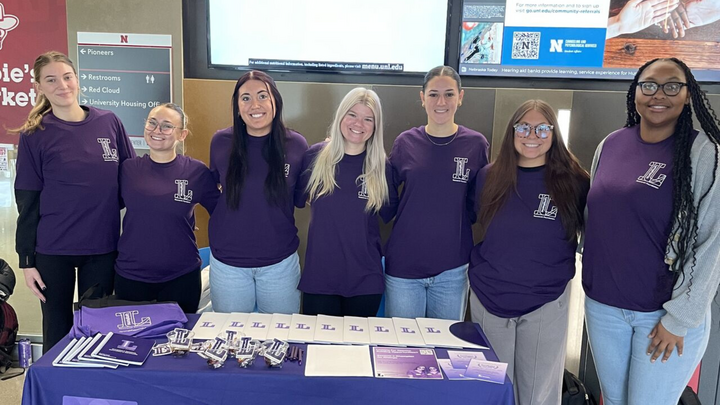The University of Nebraska–Lincoln College of Journalism and Mass Communications (CoJMC) plays a critical role in preparing students for meaningful careers across a fast-changing media and communications landscape. As the university looks ahead, a clear understanding of current and projected employment trends is essential for strategic planning and program development.
This report analyzes the occupational outlook for roles aligned with the college’s academic programs, drawing from national employment projections (Bureau of Labor Statistics, 2023–2033), Nebraska long-term occupational projections (Projections Central, 2022–2032), and national industry sector data. It highlights key areas of growth and decline relevant to graduates of CoJMC’s undergraduate programs in Advertising and Public Relations, Broadcasting, Journalism, and Sports Media and Communication, as well as graduate programs in Strategic Communication, Public Relations, and Sports Promotion.
The U.S. economy overall is expected to grow 4%, adding 6.7 million jobs between 2023 and 2033.
The findings are intended to guide decision-making and ensure the college continues to deliver programs that meet workforce needs, anticipate industry shifts, and equip students with skills that are increasingly in demand across sectors.
National and Nebraska Outlook
Graduates of the College of Journalism and Mass Communications face a strong job market, though the nature of those opportunities is shifting. While some traditional media roles are declining, emerging roles—especially those focused on digital content, market research, and strategic communication—are seeing significant growth, both nationally and in Nebraska.
Strong Growth in Digital and Marketing Roles
Occupations requiring digital fluency and market research skills are among the fastest-growing areas. Nationally, market research analysts and marketing specialists are projected to grow by 8.3% and 8.2%, respectively, with average annual openings of 88,500 and 34,800. In Nebraska, the outlook is even more optimistic: market research analysts are expected to grow by 14.9%, with 470 annual job openings, while marketing managers will grow 7.6%, adding about 80 jobs annually.
Demand for web and digital interface designers is also rising sharply—7.9% growth nationally (9,900 openings annually) and 16% in Nebraska (70 openings). These trends emphasize the growing need for professionals skilled in digital marketing, data analysis, and managing a strong online presence.
Continued Demand in Content Creation and Production
Media production roles remain strong, particularly for those managing and executing visual and multimedia projects. Producers and directors are projected to grow by 8% nationally (13,900 annual openings) and 7.7% in Nebraska (40 openings). Film and video editors will see especially high growth in Nebraska at 10%, reflecting continued investment in visual content creation.
Varied Outlook for Creative Roles
Growth in creative professions is mixed but still promising, particularly at the state level. Art directors are projected to grow moderately at 5.2% nationally, but much faster in Nebraska at 11.1%. Similarly, graphic designers show modest national growth (2.5%) but stronger state-level prospects (7.4%). Photographer roles are projected to grow slowly—3.9% nationally and 2.6% in Nebraska—indicating that while demand exists, it's concentrated in niche or specialized markets.
Positive Growth in Public Relations and Fundraising
Strategic communication and development roles are steadily growing. Public relations specialists are expected to increase by 6.2% nationally (27,100 annual openings) and 8.1% in Nebraska. PR managers also show similar trends, growing 6.9% nationally and 7.8% in the state. Fundraising roles are rising as well, with fundraisers projected to grow by 5.9% nationally and 8.1% in Nebraska; fundraising managers are close behind at 7.4% growth within the state. Challenges in Traditional Media
Traditional media roles are experiencing decline, particularly in Nebraska. Editors are projected to decline by 2% nationally and by 9.4% in Nebraska. Proofreaders and copy markers face declines of 3.4% nationally and 14.3% in Nebraska. News analysts, reporters, and journalists also face reductions of 2.7% nationally and 7.6% in the state. Broadcast technicians are expected to remain flat in both contexts.
Interestingly, advertising and promotions managers are forecast to decline nationally by 2.6%, but grow by 5.9% in Nebraska, highlighting regional differences in how traditional roles are evolving.
The job market for journalism and mass communications graduates remains strong, but the focus is shifting. Skills in digital media, research, content production, and strategic communication are increasingly in demand, particularly in Nebraska. While traditional media roles are contracting, emerging and evolving occupations offer a wide range of new opportunities for graduates ready to adapt to the changing landscape.
National Occupational Growth by Industry Sector
Graduates of the College of Journalism and Mass Communications (CoJMC) are well-positioned for a wide range of career opportunities. While opportunities remain strong in sectors like Information (newspapers and broadcast outlets) and Professional, Scientific, and Technical Services (advertising, marketing and public relations agencies), the skills our graduates develop—storytelling, research, strategic communication, media production, and data analysis—are in demand across the entire economy. Employers in nearly every industry recognize the value of effective communication, digital expertise and audience engagement.
Professional, Scientific, and Technical Services (+71,330)
This sector includes advertising, PR, and market research firms—traditional strongholds for CoJMC graduates. The sector is projected to add 71,300 jobs, with especially strong growth in key communication-related roles:
- Market research analysts and specialists (+29,600): Reflecting a growing demand for professionals who can conduct research, interpret consumer behavior and market trends.
- Marketing managers (+12,500): Leading strategy and outreach efforts across firms seeking to grow and connect with audiences.
- Graphic designers (+6,600): Visual communication remains essential as businesses prioritize design for digital and print media.
- Web and digital interface designers (+5,200): Increasing demand for professionals who can craft intuitive, engaging online experiences.
- Public relations specialists (+6,600): Highlighting the growing need to manage organizational image and stakeholder engagement.
Information (+21,600)
The Information sector—home to news media, digital content, and telecommunications—continues to evolve. While some traditional journalism roles are declining, overall growth remains positive, with the sector adding 21,600 jobs:
- Market research analysts and marketing specialists (+8,900): Essential for understanding digital audience behaviors.
- Marketing managers (+4,300): Developing and implementing strategies for digital engagement and content distribution.
- Public relations specialists (+900): Managing public image and media relations in a shifting content landscape.
- Web and digital interface designers (+4,000): Indicative of the sector’s shift toward digital-first platforms.
At the same time, traditional roles such as news analysts, reporters, and journalists and editors are projected to decline, suggesting a contraction in legacy newsrooms—but also a transformation toward strategic and digital communication.
Expanding Opportunities Across Diverse Sectors
Finance and Insurance (+13,400)
This sector relies heavily on trust, reputation management, and customer engagement—all areas where communication professionals play a critical role.
- Market research analysts and marketing specialists (+7,500)
- Marketing managers (+3,300)
- Public relations specialists (+1,300)
These roles support branding, the marketing of complex financial products, and public communication in highly regulated environments. CoJMC graduates bring the research, messaging, and strategy skills essential for success in these high-stakes roles.
Other Services (Except Public Administration) (+12,100)
This diverse sector includes nonprofits, associations, and mission-driven service organizations that increasingly rely on strategic communication to advance their goals.
- Fundraisers (+3,100): Vital for organizations depending on donor support and philanthropic outreach.
- Public relations specialists (+3,100)
- Market research analysts and marketing specialists (+2,000)
These roles emphasize audience insight, mission storytelling, community engagement, and outreach strategy—all central to the training CoJMC students receive.
Health Care and Social Assistance (+10,000)
Communication is central to healthcare—whether educating the public, building trust, or mobilizing support.
- Public relations specialists (+3,100): Supporting public health campaigns, patient communication, and institutional reputation.
- Fundraisers (+3,100): Especially vital for nonprofit hospitals, clinics, and social assistance programs.
As healthcare systems evolve, so does the demand for skilled communicators who can convey complex information clearly and compassionately.
Arts, Entertainment, and Recreation (+7,000)
From stadiums to streaming platforms, communication fuels the fan experience and connects audiences to culture, creativity, and competition.
- Producers and directors (+1,900): Sports broadcasting and live events need skilled storytellers—JMC students train in directing, editing, and production management
- Audio and video technicians (+500): Growing demand for sports coverage boosts need for tech pros—JMC’s media production track builds those skills.
As sports and entertainment continue to converge, communicators who can produce, capture, and amplify the moment will be in high demand.
Limited Growth in Communication Roles Expected in Several Sectors
While many industries are expanding their communication workforce, others show limited opportunity for CoJMC graduates in the near term.
The Retail Trade sector is the only sector projected to see a net loss of 900 communication-related jobs, reflecting shifts toward automation and centralized marketing operations. Other sectors, though growing overall, offer only modest gains for communication professionals. These include Manufacturing (+1,500), Transportation and Warehousing (+1,500), Utilities (+1,400), Public Administration (+1,500), and Real Estate and Rental and Leasing (+1,900).
Of note, Agriculture, Forestry, Fishing and Hunting is projected to add just 100 communication-related jobs. While agriculture remains a foundational Nebraska industry, the data suggest that dedicated communication roles are not growing significantly within the sector itself.
These trends underscore the importance of aligning communication skills with industries where demand is strongest and most dynamic.
Conclusion
The employment outlook for journalism and mass communications graduates is strong, particularly for those prepared to lead in digital strategy, communication research, content creation, data-informed communication and public engagement. While traditional media roles are shrinking, the broader economy is generating significant opportunities in areas where CoJMC students excel—from market research to media production, public relations and fundraising.
By staying aligned with these trends and continuing to evolve its academic offerings, the College of Journalism and Mass Communications can ensure its graduates remain competitive, adaptable, and in demand across Nebraska and the nation. The future of communication is not only promising—it is expanding, and CoJMC graduates are well-positioned to lead it.




